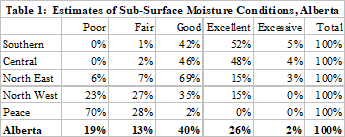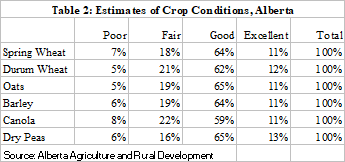| |
Precipitation received during the last two weeks varied considerably across the province. In the Peace Region, it was more than 20 mm in the northern parts, but less than 20 mm in most southern and central areas, where dry conditions remain a major concern. For the rest of the province, rain has brought 30 to more than 100 mm of moisture to the Central, North East and North West Regions. This was welcome in replenishing moisture reserves, but has also hampered field operations, and left water standing in many low-lying fields. In the Southern Region, amounts of moisture received are moderate, ranging mostly from 10-40 mm. Overall, soil moisture reserves in the province are adequate to excessive, with the exception of southern and central areas of the Peace Region. Table 1 below presents estimates of sub-surface moisture conditions for the province, by region.
Provincially, about 75 per cent of spring cereals and 70 per cent of canola are in good to excellent condition (see Table 2). It is worth mentioning, crop conditions in the southern and central areas of the Peace Region have deteriorated significantly, due to the lack of moisture. Winter cereals in the province are generally reported as good to excellent, while specialty crops under irrigation, primarily in the Southern Region, are rated as fair to good. Overall, canola and dry peas are flowering, and early seeded spring cereals are heading out. Crop development remains 10-20 days behind normal in the Southern Region, and 7-10 days behind normal in the Central, North East and North West Regions. This is mainly due to the delayed seeding, and to some extent, cool, damp weather conditions.
The first cut haying operation is estimated at 30 per cent complete. Yields are below average in the Peace Region, and about average in the North West Region. Elsewhere in the province, yields are mostly above average. Overall, hay quality ranges from fair to excellent. The recent rain has slowed haying operations and is likely to result in some quality deterioration for hay in swath.
Pasture growth has benefited significantly from the recent rain, and is rated as 12 per cent poor, 14 per cent fair, 47 per cent good, and 27 per cent excellent. Spraying for sclerotinia is reported in many areas of the province, and there are pest problems with lygus bugs, army cutworms, root maggots, and gophers.


Our thanks to Alberta Agricultural Fieldmen, staff of AFSC and the Alberta Ag-Info Centre for their partnership and contribution to the Alberta Crop Reporting Program.
Regional Assessments:
The 2010 Alberta Crop Report Series continues to provide summaries for the following five regions:
Region One: Southern (Strathmore, Lethbridge, Medicine Hat, Foremost)
- Rain showers during the last two weeks have brought moderate amounts of moisture to the region, mostly ranging from 10-40 mm. Moisture reserves are good to excellent, and even excessive in some areas.
- Crop development for major and specialty crops is mostly 10-20 days behind normal. Oilseeds and pulses are flowering, and early seeded spring cereals are heading out. Overall, spring cereals are rated as 12 per cent poor, 25 per cent fair, 50 per cent good, and 13 per cent excellent, while canola is 12 per cent poor, 31 per cent fair, 47 per cent good, and ten per cent excellent. In some areas, hailstorms have caused light to moderate crop damage. Due to the heavy rain in June, some fields have been left unseeded for the year, and significant amounts of crop acres have been lost to flooding.
- The first cut haying operation is well under way, with above average yields reported for both dryland and irrigation. Pasture is generally in good to excellent condition.
Region Two: Central (Rimbey, Airdrie, Coronation, Oyen)
- During the last two weeks, the region has received 30 to more than 100 mm of precipitation, with heavy rain reported in the areas of Red Deer, Lacombe, Ponoka and Stettler. Soil moisture conditions are generally good to excellent, but excessive in some areas. Rain has left water standing in many low-lying fields.
- Crop development is mostly 7-10 days behind normal, although some warm temperatures have been beneficial to crops, particularly canola. Crop conditions for spring wheat and barley are rated as one per cent poor, 18 per cent fair, 72 per cent good, and nine per cent excellent, while canola is three per cent poor, 28 per cent fair, 61 per cent good, and eight per cent excellent. Also reported in some areas were localized hailstorms causing crop damage.
- The adequate moisture reserves have boosted pasture and tame hay growth. Yields from the first cut are above average, while the recent rain has likely resulted in some quality deterioration for hay in swath.
Region Three: North East (Smoky Lake, Vermilion, Camrose, Provost)
- Rain during the last two weeks has brought 30 to more than 100 mm of moisture to the region, and left water standing in many low-lying fields. Soil moisture reserves are adequate, but excessive in some areas.
- Crop conditions have been improving, but development remains 7-10 days behind normal. Spring wheat and barley are rated as one per cent poor, nine per cent fair, 78 per cent good, and 12 per cent excellent, while canola is reported as two per cent poor, 15 per cent fair, 71 per cent good, and 12 per cent excellent. Hailstorms have caused moderate to severe crop damage in some areas of the region.
- Hay yields from the first cut are above average. The recent rain has slowed haying operations and is likely to result in some quality deterioration for hay in swath. Pasture is generally rated as good to excellent.
Region Four: North West (Barrhead, Edmonton, Leduc, Drayton Valley, Athabasca)
- Precipitation received during the last two weeks ranged from 60 to more than 100 mm in most southern parts of the region, and 30 to 70 mm in other areas. Overall, soil moisture reserves are adequate. Excessive moisture, commonly with water standing in low-lying fields, is reported in some southern areas.
- Crops are mostly in good condition, despite development lagging 7-10 days behind normal. Spring wheat is rated as six per cent fair, 76 per cent good, and 18 per cent excellent, while canola is one per cent poor, ten per cent fair, 70 per cent good, and 19 per cent excellent. Also, some areas have reported crop damage due to hailstorms.
- The recent rain has slowed haying operations, and is likely to result in some quality deterioration for hay in swath. Tame hay and pasture conditions vary, mostly ranging from fair to excellent.
Region Five: Peace River (Fairview, Falher, Grande Prairie, Valleyview)
- Scattered rain showers during the last two weeks have brought less than 20 mm of moisture to most central and southern areas of the region, while the northern and southeastern parts have received more than 20 mm. In most areas of the region, dry conditions remain a major concern, as rain is badly needed.
- Crop conditions have deteriorated in the southern and central areas of the region, due to inadequate moisture. Overall, spring wheat is rated as 20 per cent poor, 35 per cent fair, 41 per cent good, and four per cent excellent, while canola is 22 per cent poor, 34 per cent fair, 39 per cent good, and five per cent excellent.
- The first cut haying operation is well underway. Yields are generally below average, while quality ranges from fair to excellent. Tame hay and pasture growth has been slow, and is reported as 60 per cent poor, 34 per cent fair and six per cent good.
Note to Users: The contents of this document may not be used or reproduced without properly accrediting Alberta Agriculture and Rural Development, Economics and Competitiveness Division, Statistics and Data Development Branch. |
|